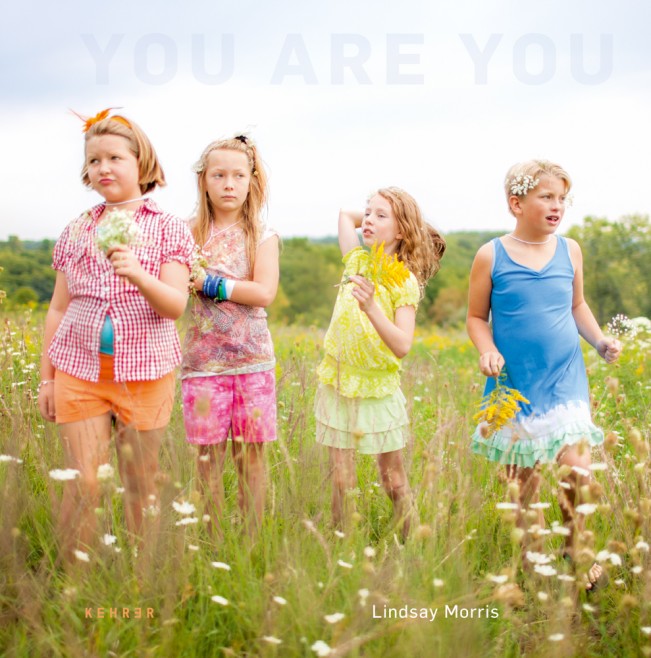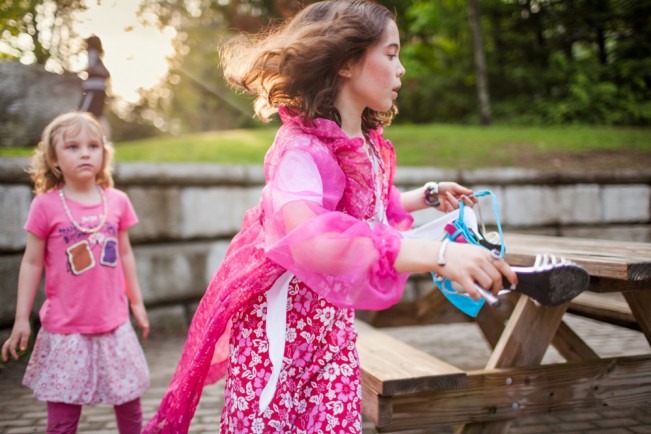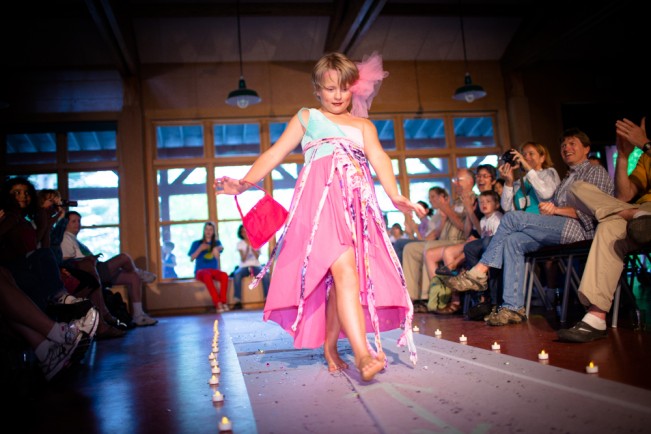Lindsay Morris: You Are You
When it comes to issues on gender this really has been an educational year. With Caitlyn Jenner making national news, and Transparent becoming an award winning hit television series, eyes are beginning to open, and long over due conversations are now being had. Similarly this year, Lindsay Morris published a book about a camp of gender-creative children. You Are You is a beautiful documentation of the innocence, freedom, and self-confidence of these children and their more than accepting families. As Lindsay photographs the community that the camp has created, you will mostly see wide-eyed smiles and heightened energy – active kids like any other. It is here, in Lindsay’s book, where we get true glimpses of what a child can be when they express themself differently.
Born and raised in suburban Detroit, Lindsay Morris began her studies at the School of the Art Institute of Chicago and holds a BFA from the University of Michigan School of Art. Since 2006 she has been a freelance photographer and photo editor for Edible East End magazine, where she documents the food culture on Long Island.
Recent exhibitions include a solo New York exhibition at Clamp Art, NY, a solo show at Rayko Photo Center, San Francisco, the Hamburg Triennial w/ Photoville Brooklyn, Sous Les Etoiles Gallery, NY, The Fence and Photoville, Atlanta and Brooklyn, NY, a solo show at the Center for Fine Art Photography, Fort Collins, CO and a selected Ctrl+P artist at the Catherine Edelman Gallery, Chicago.
Lindsay’s work has been featured on BBC World News and published in TIME Magazine, The New York Times Magazine, GEO, Days Japan, PDN, Marie Claire, Elle, Internazionale and Haaretz Israel, and has been featured on photography blogs vice, L’Oeil de la Photographie, WPO, Slate/Behold and abcNews.com. She was a 2013 Critical Mass finalist and nominee for the 2013 Julia Margaret Cameron Award.
Her first book, You Are You, documenting a weekend summer camp for gender- variant children, has recently been published in partnership with Kehrer Verlag.
You Are You
You Are You documents an annual weekend summer camp for gender-creative children and their families. This camp offers a temporary safe haven where children can freely express their interpretations of gender alongside parents and siblings without feeling the need to look over their shoulders.
In 2007 I started attending camp with a family member. It was with a great deal of courage in 2012, that the camp parents and children agreed to have selected images published as the cover story of the New York Times Magazine. This started what we all agreed was a very important and timely dialogue in a public forum. Since then this story has been published in 13 countries, in 10 languages, demonstrating a common global interest in the predicament of gender- independent youth.
By sharing this unique story, I intend to reach beyond the confines of the camp to contribute to a dialogue about the crucial role that support plays in the lives of gender-creative children. A lack of understanding of gender identity and the ways in which these children express themselves often leads to discrimination. Through these images the viewer will experience something different; a groundbreaking, heart-opening place that serves as the backdrop for this important moment in history; where the first gender-creative childhood is being freely expressed.
Can you go more into detail about this camp, and how you found out about it?
Camp You Are You (a pseudonym to protect the privacy of the participants) is a weekend summer camp for gender-variant children and their affirming families. I was brought to camp by a loved one, at a time when the community was in its’ infancy. It started with a support group for parents of gender-unique children in Washington, D.C. at the Children’s National Medical Center. This circle of nurturing parents and the psychiatrist who formed the group created a web forum where vetted family members from across the country could communicate in a virtual support group. Over time the parents, sharing this common thread, wanted to get to know each other and to offer the opportunity for their children to come face to face with other kids who identified as they did. Hence, the camp. We are family organized and entirely volunteer based, so I suppose you could say it’s more like a family reunion than an official camp.
While putting the book together did you have a directed audience in mind?
My intention for the book was twofold. You Are You straddles the line between a fine art photography book and a helpful book of resources, with essays, reading lists and national LGBT organizations available both in the book and on the book website, youareyouproject.com.
It’s a tall order, but I think we succeeded. You Are You offers helpful information for those intent on advocating for LGBT youth, while appealing to the documentary/fine art photography audience.
Outside of the book, do you see this work functioning somewhere else?
You Are You gives the viewer a glimpse into a world seldom seen. The traveling exhibition which can currently be seen at the Sun Valley Center for the Arts in Idaho, is an opportunity for the general public to experience what true support looks like. I see the exhibition functioning to untangle our perception of gender-nonconformity during this huge shift in attitudes toward the LGBT community, that’s evolving globally. The conversation is on its’ way, and the courage of the camp families and their willingness to go public with their experiences, can only help move the dialogue forward. I plan to travel the show for as long as seems necessary.
I think that the spirit of these images are beautiful, and it is painful that some might approach these photographs with baggage. What were some of the challenges you faced while making this work?
Making the work wasn’t the challenge. As a member of the camp community, it was possible to collaborate with the children and the parents. We named the book together and participated in a virtual crossing of fingers while going public in August 2012 as the cover story of the NY Times Magazine. Once we gathered the nerve to open the pages of this brilliantly researched piece by Ruth Padawer and with my photographs splashed over six pages, we breathed a sigh of relief. The sky didn’t fall, the earth didn’t cave beneath our feet; yes there were some unsavory comments which were closely monitored by the NY Times, but for each comment by someone challenged by our story, there were several readers patiently and thoughtfully giving a more supportive take on the subject. It was truly an education for all of us. I think it was this kind of exposure which gave us the courage to forge on. A father from the group expressed that only through visibility were we truly likely to move the conversation forward, and move it forward we have (with a little help from Caitlyn Jenner). Two years ago this kind of progress toward LGBT rights, especially transgender rights, seemed implausible. Today, we’re in motion, and the first gender-creative childhood is being authentically expressed in our schools and our communities. The definition of male and female is expanding along the lines of a broad gender spectrum while a new vocabulary is evolving. I could go on and on. We have a lot of hope and take a lot of pride in our small part in history. I’m proud that through photography, I could help illustrate this unique journey.
What would a typical day look like at the camp?
The goal of the parents is to create a traditional summer camp atmosphere. The children swim and kayak, they participate in ropes course and zip-line activities for team building and in the evening sit around a large campfire singing songs and roasting marshmallows. Children at camp are welcome to dress as they choose, safely and free from judgment. This may not be typical for many, so there is this mixed energy of relief and exhilaration. You sense how liberated they feel, and yet the camp is only four days, so there’s definitely an awareness of the passing of time.
Are you currently working on new projects, or still working with this one?
Although I will continue to follow the camp community and the children as they progress into adulthood, I’ve embarked on a new project which involves getting acquainted with my neighbors. I’m taking a new look at the town that I have made my home, and the everyday people that surround me. My children are more grown up and I have begun to take inventory of my surroundings. For years I’ve felt I would have to travel to a foreign place to find anything of interest, but as I look across the lawns of my neighbors, I am intrigued by their mundane activities, their home lives and the objects in their yards. The first house I visited was a stop on the underground railroad. I was invited in by the family to look at the dirt floor closet and a hole that leads to the Zionist Church, also a safe haven on the underground railroad. Showing up , but a story that I believe is worth telling. There was a time when we knew our neighbors. Today we hide behind our hedges, our cell phones, our front doors. My neighbors each have their personal histories and I am discovering them one house at a time.
Also freelancing for the New York Times.
Posts on Lenscratch may not be reproduced without the permission of the Lenscratch staff and the photographer.
Recommended
-
Kevin Cooley: In The Gardens of EatonJanuary 8th, 2026
-
William Karl Valentine: The Eaton FireJanuary 7th, 2026
-
Sean Stanley: Ashes of SummerJanuary 6th, 2026
-
Nathan Bolton in Conversation with Douglas BreaultJanuary 3rd, 2026
-
Andrew Lichtenstein: This Short Life: Photojournalism as Resistance and ConcernDecember 21st, 2025













































































